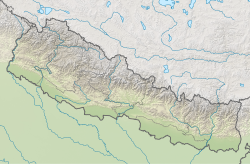
Back कपिलवस्तु Bihari কপিলাবস্তু Bengali/Bangla কপিলাবস্তু BPY Kapilavastu Catalan Kapilavastu Czech Kapilavastuo Esperanto Kapilavastu Spanish Kapilavastu French कपिलवस्तु Hindi Kapilavastu (kota kuno) ID
| Pilgrimage to |
| Buddha's Holy Sites |
|---|
 |
Kapilavastu was an ancient city in the eastern Gangetic plains of Indian subcontinent which was the capital of the clan gaṇasaṅgha or "republic" of the Shakyas in the late Iron Age, around the 6th and 5th centuries BC. King Śuddhodana and Queen Māyā are believed to have lived at Kapilavastu, as did their son Prince Siddartha Gautama (Gautama Buddha) until he left the palace at the age of 29.[2]
Buddhist texts such as the Pāli Canon say that Kapilavastu was the childhood home of Gautama Buddha, on account of it being the capital of the Shakyas, over whom his father ruled.[2] Kapilavastu is the place where Siddhartha Gautama spent 29 years of his life. According to Buddhist sources the name Kapilvatthu means "tawny area", due to the abundance of reddish sand in the area.[3][4]
Kapilavastu never became a major pilgrimage site like Buddha's birthplace at Lumbini not far away, which would have left unmistakable remains. The settlement was probably never as large as depictions in early Buddhist art suggest, and after the decline of Buddhism in India its location faded into obscurity.[citation needed] There are now two sites near the border between Nepal and India which are claimed as Kapilavastu — Piprahwa in Uttar Pradesh, India and Tilaurakot in Nepal. Finds at the Piprahwa (including a reliquary found inside a mud stupa) indicate Buddhist activity dating to the 5th-4th century BCE, around the time of the death of the Buddha.[5]
- ^ Marshall, John (1918). Guide To Sanchi, Calcutta: ASI; p.64]
- ^ a b Trainor, K (2010). "Kapilavastu". In Keown, D; Prebish, CS (eds.). Encyclopedia of Buddhism. Milton Park, UK: Routledge. pp. 436–7. ISBN 978-0-415-55624-8.
- ^ Kapila, PTS Pali English Dictionary. Link: https://suttacentral.net/define/kapila
- ^ Suttacentral
- ^ Srivastava, KM (1980). "Archaeological Excavations at Piprāhwā and Ganwaria and the Identification of Kapilavastu". The Journal of the International Association of Buddhist Studies. 13 (1): 103–10.
© MMXXIII Rich X Search. We shall prevail. All rights reserved. Rich X Search


